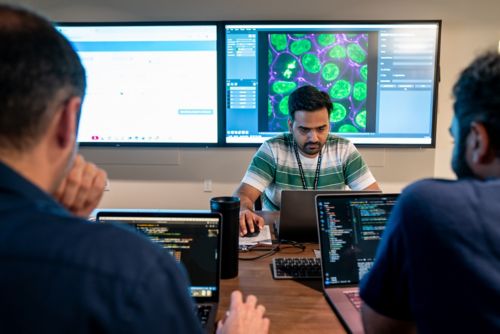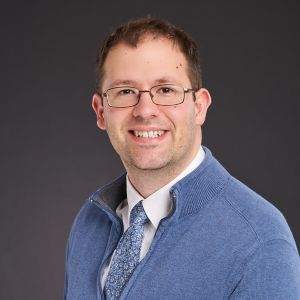St. Jude Family of Websites
Explore our cutting edge research, world-class patient care, career opportunities and more.
St. Jude Children's Research Hospital Home

- Fundraising
St. Jude Family of Websites
Explore our cutting edge research, world-class patient care, career opportunities and more.
St. Jude Children's Research Hospital Home

- Fundraising
St. Jude BioHackathon solves complex research problems and advances participants careers

Participants in the St. Jude BioHackathon utilize skills in data science to help advance research.
Biohacking sounds like something out of science fiction, but the St. Jude BioHackathon is bringing about real and meaningful changes in research, patient care and participants’ careers. The institution recently hosted the third annual BioHackathon, a three-day marathon coding session during which participants develop software-based solutions to challenging problems the St. Jude community faces.
“It’s an opportunity to work on high-risk problems that we may not otherwise be able to work out,” said Jared Andrews, PhD, a senior bioinformatics research scientist in the St. Jude Department of Developmental Neurobiology and co-organizer of the BioHackathon. “It’s a risk-free opportunity to learn from other people and fields that you typically don’t get to work on in your day-to-day job. It is personal development mixed with useful projects for the community.”
“We have the community of St. Jude submit problems that could use a software solution,” explained Susanna Downing, MS, a bioinformatics research scientist in the St. Jude Department of Cell and Molecular Biology and co-organizer of the event. “Anyone is allowed to submit problems and participate, so we have a range of projects available to work on.”
In contrast to other hackathons, St. Jude does not restrict attendance to only those with a strong computational background but instead welcomes people from many positions. Building the community and expanding participants’ skills are major goals. Projects range from building tools to approach outstanding research questions in novel ways to addressing institutional data management challenges to improving routine processes for maintaining and monitoring St. Jude infrastructure.
The Biohackathon solves problems and pushes careers forward
Christy LaFlamme, a current PhD student at the St. Jude Graduate School of Biomedical Sciences, used the inaugural BioHackathon, held in 2022, to launch her research forward. Graduate students must publish at least one first-author peer-reviewed publication of their work to defend as part of their thesis. The hackathon served as a chance to learn from more senior researchers and get input on her work that could accelerate her progress.
LaFlamme led a team that created a tool to examine chemical modifications of DNA that affect gene expression: epigenetic markers. They focused on methylation, where a small methyl group is added to DNA’s structure. The pipeline they built, MethylMiner, is now available on GitHub, a platform programmers use to freely share their code, and led, in part, to a first-author peer-reviewed research publication.
“Our project from the 2022 BioHackathon to design a computational pipeline was instrumental for expediting my work on the epigenetics of pediatric epilepsies,” LaFlamme said. “I have published the findings in a recent article in Nature Communications. All of my BioHackathon team members were included as co-authors of the study.” The collaborative paper and software will serve as part of her thesis, providing her with a strong foundation as she presents her defense to earn her PhD.
One of the benefits of the St. Jude BioHackathon is that good ideas can come from any employee — even those who don’t work directly in the hospital’s research enterprise. That’s the case for Kennon Silence, senior technical support specialist in Facilities and Operations Maintenance (FOM). Silence has participated in all three St. Jude BioHackathons due to personal interest and a desire to expand his skill set.

Kennon Silence, center, and his fellow participants in the St. Jude BioHackathon find opportunities that help advance their careers.
“People can make the most of the opportunity; it might even lead to another career,” Silence said. “You might not know how valuable a contribution you could make until you go and make yourself available.”
While his initial position in FOM was a nonprogramming role, after attending the BioHackathon for two years and educating himself in other venues, FOM created a position to take advantage of Silence’s new technical skills. He now has the type of position he always wanted but was also able to stay within FOM. In fact, at this year’s BioHackathon he led a team investigating a software solution for a FOM logistical challenge.
Maintenance crews and technicians must regularly check equipment across campus for functionality, ranging from fire extinguishers to emergency generators. Most commercial systems to assist with their work are cumbersome, often not designed to handle the breadth of tasks required of the team, resulting in a return to physical paper documentation. Silence’s crew created an early pilot of a digital application to improve inventory tracking, ordering and the everyday experience for FOM employees.
“Even though this is just a prototype that may not be adopted, it’s nice to be able to report back to my management how much work it takes to make a whole process digital,” Silence said. “I learned how we need to be particular about our needs and constraints — as well as what early work I need to do beforehand — to set up our department for success when we are able to continue on this project.”
Their work shows how the BioHackathon can be a resource for more than just the academic community at St. Jude. Silence’s team won the “Most Innovative Project” award.
Joining the BioHackathon community to solve problems and have fun
During the BioHackathon, individuals join teams to work on specific problems. Over the 72-hour event, participants work intensively within their team to solve their problem under the direction of a team leader. The dedicated effort of the hackathon is an opportunity to solve these problems that have been challenging to solve through daily work. Creating a positive experience and long-lasting connections is just as important.
“For my first BioHackathon, I expected to be up all night, eyes glued to the screen, nonstop computer coding. While this isn’t against any rules, it certainly isn’t a requirement,” LaFlamme reminisced. “I was able to come in fresh every morning and have multiple interactions and group meetings with my team for brainstorming. I have had a blast during every BioHackathon event I participated in.”
Silence echoed a similar sentiment. During his first BioHackathon, he joined the team of Jaimin Patel, MS, a principal software engineer in the St. Jude Department of Structural Biology.
“It was a rush,” Silence said. “My first year was three days of doing the job that I’ve wanted to do for so long, and it was just like a dream. Even though I felt I couldn’t contribute much my first year, my team leader asked me back the next year.”
Silence then took on a more significant role during his second year at Patel’s insistence. Silence designed the front end of visualization software for a database of scientific papers. Despite his leader’s confidence in him, Silence was nervous.
“I had built the visualization to work with a small dataset,” he explained. “It came down to the last few minutes, and I thought it would not work when they put in the much larger real dataset. I thought the program was completely broken for a moment, and then it spilled out this beautiful graph that everybody loved.” Patel’s confidence was well-placed, pushing Silence to expand his skills in a way he would not have without the BioHackathon.

The St. Jude BioHackathon brings together individuals interested in applying data science to solve challenging research problems.
The St. Jude BioHackathon offers unique value to participants
Both LaFlamme and Silence highly recommended the BioHackathon. “You will learn something new at this event, regardless of what particular expertise or skills you bring to the table,” LaFlamme said. “Just my first year, I walked away with many new skills, including project management, exposure to software development processes and the ability to communicate with other computational researchers of different backgrounds.”
For Silence, the BioHackathon brought him closer to the St. Jude mission. “It’s a chance to participate in something you can sometimes feel removed from,” he said. “As a whole organization, we’re working for the patients, but you can be so many steps away from them that it’s hard sometimes to feel like you’re contributing. It’s nice to have a more direct connection at times to the noble endeavor of the research going on here.”
While the KIDS24 BioHackathon is over now, the KIDS25 BioHackathon is less than a year away. Teams are already planning projects for next year, and potential attendees can begin considering participation.
“For those think about participating, I’d tell them the BioHackathon is what you make of it,” Silence advised. “You don’t know what opportunities you might get into that might lead to something bigger. But the first step is to show up.”






